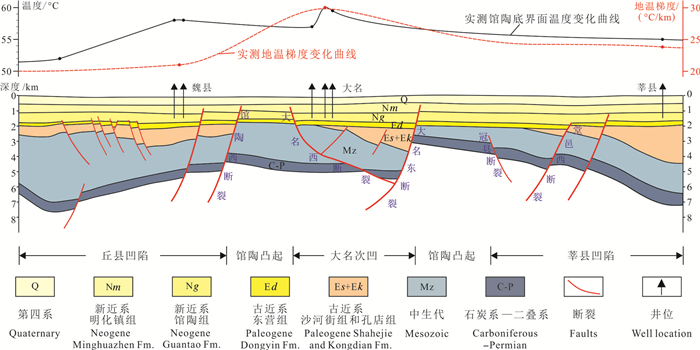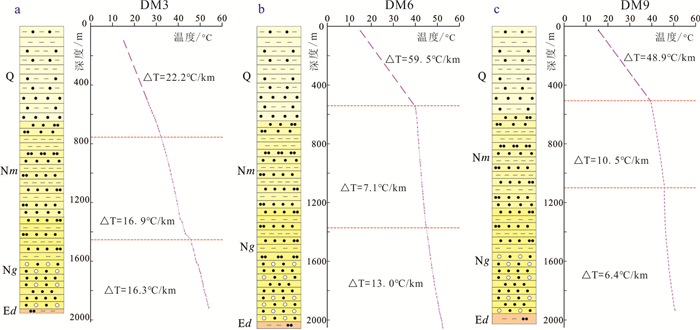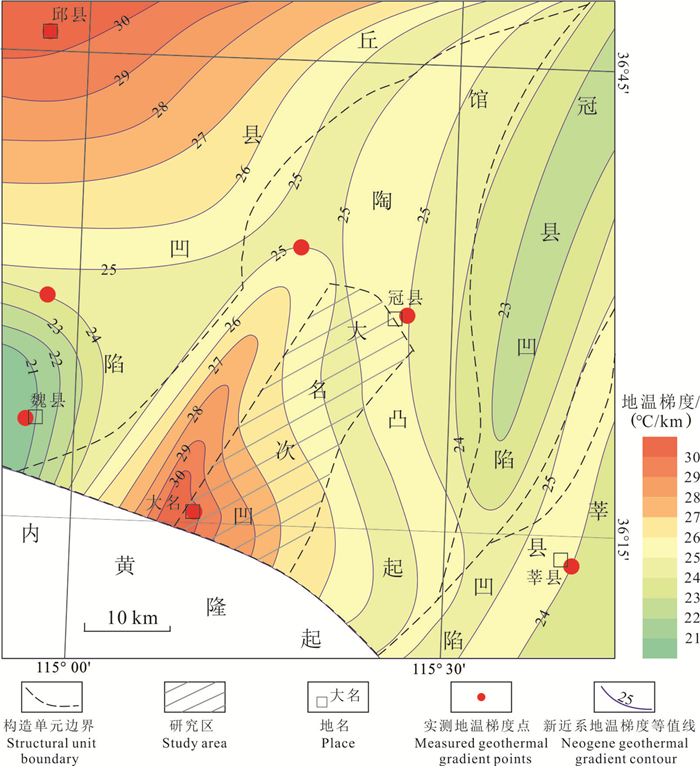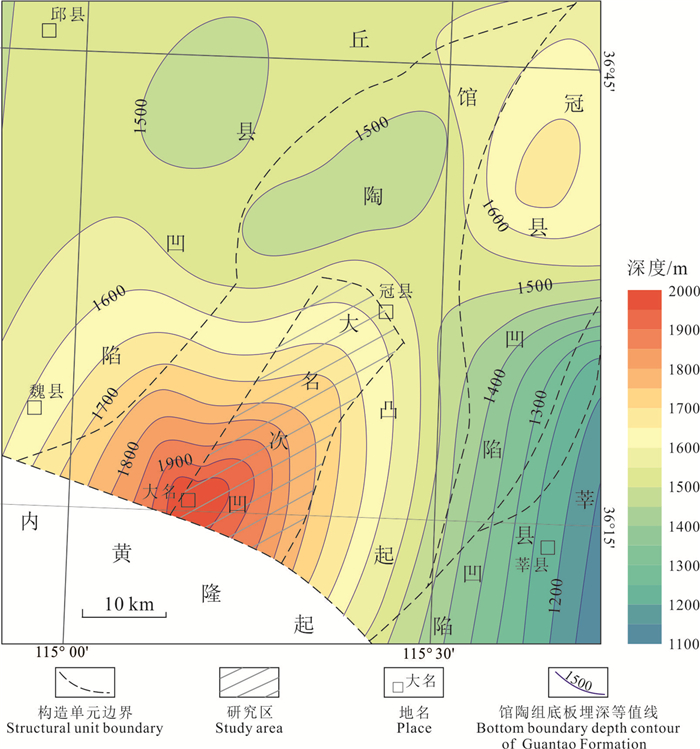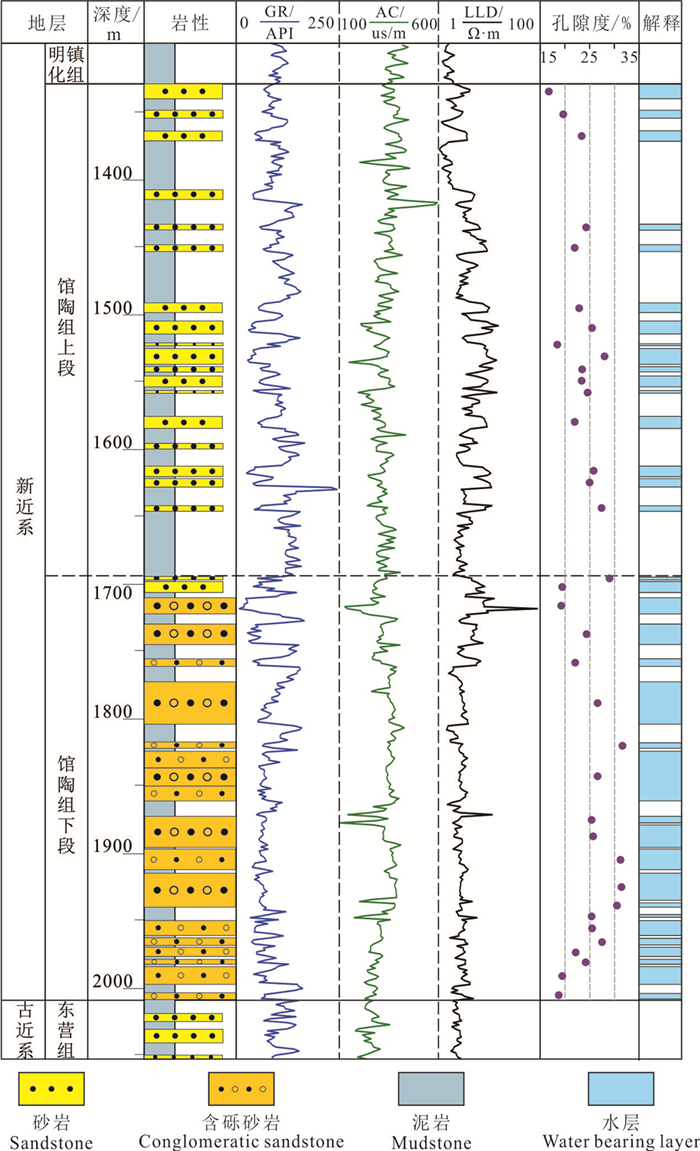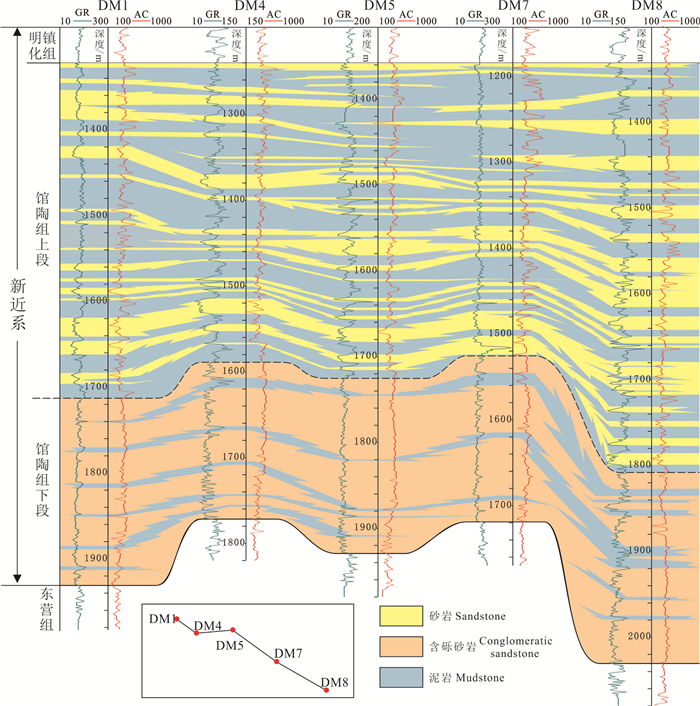Genetic mechanism of geothermal system in Daming Sag, Linqing Depression in the junction of Hebei, Shandong and Henan Provinces and its exploration potential
-
摘要:
研究目的 建立地热系统的成因模式对地热田地热资源量评价以及后期有利区带的优选有着重要指导作用。大名次凹陷为渤海湾盆地临清坳陷馆陶凸起南端的一个次一级构造单元,其馆陶组砂岩热储可以构成一套完整的地热系统。
研究方法 本文结合前人研究成果和区内地热钻井资料,通过对临清坳陷大名次凹陷地热系统“源、储、通、盖”主要地质因素分析研究,建立了研究区地热系统的概念模型,并在此基础上开展了地热资源量评价。
研究结果 馆陶组热储层在区内分布均一,底板埋深在1550~2000 m,储层厚度在268~324 m,孔隙度介于14%~32%,储厚比最高可达70%。区内钻遇至馆陶组的地热井,地热水井口水温多在54~60℃,水化学类型以Cl·SO4-Na为主。上部沉积的第四系和明化镇组,地温梯度在22~60℃/km,构成了良好的盖层。地热系统热源主要来自于新生代断陷盆地背景下的高大地热流值,约52~57 mW/m2,南部临漳—大名断裂和东部冠县断裂为其深部热流向上运输的有利通道。热储整体接受来自西部太行山和东部鲁西南隆起的大气降水补给,经深部热传导和局部热对流增温后,富集于热储之中。
结论 馆陶组砂岩地热系统资源量超过127.42×108 GJ,每年可开采地热资源量为31.86×106 GJ,折合标煤1.09×106 t。年开采地热资源量可满足超3.14×107 m2的供暖面积,开发潜能较大。
Abstract:This paper is the result of geothermal survey engineering.
Objective Building genetic model of the geothermal system plays an important guiding role in the evaluation of the geothermal resources of the geothermal field and the later selection of favorable zones. Daming Sag is a secondary structural unit at the southern of Guantao Uplift in Linqing Sag, Bohai Bay Basin. The sandstone thermal reservoir of Guantao Formation can form a complete geothermal system.
Methods Combining previous research results and regional geothermal drilling data, through analysis and research on the main geological factors of the "source, reservoir, migration, and cover", the conceptual model of the geothermal system was established in Daming Sag, Linqing Depression. On this basis, a evaluation of geothermal resources was carried out.
Results The thermal reservoirs of the Guantao Formation are uniformly distributed in the area, the floor depth is between 1550-2000 m, the thickness of the reservoir is between 268-324m, the porosity is between 14%-32%, and the reservoir-thickness ratio can reach up to 70%. The geothermal wells drilled into the Guantao Formation in the area, its water temperature is about 54-60℃, and the water chemistry type is mainly Cl×SO4-Na. The upper Quaternary and Minghuazhen Formation strata have a geothermal gradient between 22-60℃/km, forming a good cap layer. The heat source comes from the high geothermal value background of the Cenozoic rift basin, about 52-57 mW/m2. The Linzhang-Daming fault in the south and the Guanxian fault in the east are favorable channels for the upward transportation of deep heat. The geothermal system receives the atmospheric precipitation replenishment from the Taihang Mountains in the west and the southwestern Luxinan uplift in the east. After being warmed by deep heat conduction and local heat convection, it is enriched in the reservoir.
Conclusions The evaluation results of the geothermal resources in the Damingci Depression show that the sandstone geothermal system resources of the Guantao Formation are more than 127.42×108 GJ, the annual geothermal resources that can be exploited are 31.86×106 GJ equivalent to 1.09×106 t of standard coal. The annual exploitation of geothermal resources can meet the heating area over 3.14×107 m2, and the development potential is great.
-
Key words:
- geothermal system /
- genetic model /
- resource evaluation /
- heating area /
- Daming Sag /
- geothermal survey engineering
-

-
表 1 大名次凹陷水化学分析数据
Table 1. Chemical composition and information of groundwater samples in Daming Sag

表 2 大名次凹陷地热井补给高程计算表
Table 2. Parameter and supply elevation calculation results of Daming Sag
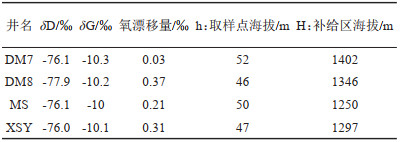
表 3 大名次凹陷馆陶组地热资源评价参数取值与计算结果(热储体积法)
Table 3. Evalution parameters and calculation results of Guantao Fm. geothermal resources in Daming Sag by reservoir volumn method

表 4 大名次凹陷馆陶组地热资源评价参数取值与计算结果(回灌法)
Table 4. Evalution parameters and calculation results of Guantao Fm. geothermal resources in Daming Sag by recirculation method

-
Cao Yingzhuo, Bao Zhidong, Lu Kai, Xu Shiqi, Wang Guiling, Yuan Shuqin, Ji Hancheng. 2021 Genetic model and main controlling factors of the Xiongxian geothermal field[J]. Acta Sedimentologica Sinica, 39(4): 863-872(in Chinese with English abstract).
Craig H. 1961. Isotopic variations in meteoric waters[J]. Science, 133(3465): 1702-1703. doi: 10.1126/science.133.3465.1702
Cui Yang, Gao Shengping, Wei Yingying, Mu Haidong. 2013. Analysis of geothermal resources in Handan[J]. Science and Technology of West China, 12(12): 18-19(in Chinese with English abstract).
He Zhiliang, Feng Jianyun, Zhang Ying, Li Pengwei. 2017. A tentative discussion on an evaluation system of geothermal unit ranking and classification in China[J]. Earth Science Frountiers, 24(3): 168-179(in Chinese with English abstract).
Hua Jieming, Wang Zhenfeng. 2006. Utilization and development of geothermal resources in eastern Hanxing Plain (Southern Hebei Depression), Heibei Province[J]. Coal Geology of China, 18(1): 34-37(in Chinese with English abstract). doi: 10.3969/j.issn.1674-1803.2006.01.012
Jiang Guangzheng, Gao Peng, Rao Song, Zhang Linyou, Tang Xiaoyin, Huang Fang, Zhao Ping, Pang Zhonghe, He Lijuan, Hu Shengbiao, Wang Jiyang. 2016. Compilation of heat flow data in the continental area of China (4th edition)[J]. Chinese Journal of Geophysics, 59(8): 2892-2910(in Chinese with English abstract).
Jing Chenghu. 2007. A Study on Geologic Features of Geothermal and its Exploitation and Utilization in the Eastern Plain of Handan[D]. Beijing: China University of Geosciences (Beijing).
Lang Xujuan. 2016. The Thermal Structure and Geothermal Genesis Mechanism in Guide Basin[D]. Beijing: Chinese Academy of Geological Science.
Liu Jianping, Wang Xinwen, Lu Yanwen. 2002. The Cenozoic extended basin characterand models in the east of Linqing[J]. Journal of Chengdu University of Technology, (5): 551-554(in Chinese with English abstract). doi: 10.3969/j.issn.1671-9727.2002.05.014
Liu Jianping, Wang Xinwei, Wang Xinwen. 2004. Transition structures in Linqing depression[J]. Geological Science and Technology Information, 23(4): 51-54 (in Chinese with English abstract).
Liu Jianrong, Song Xianfang, Yuan Guofu, Sun Xiaomin, Liu Xin, Wang Shiqin. 2009. Characteristics of δ18O in precipitation over eastern monsoon China and the water vapor sources[J]. Chinese Science Bulletin, 54(22): 3521-3531(in Chinese with English abstract). doi: 10.1360/csb2009-54-22-3521
Liu Xiangyang, Gong Hanhong. 2007. An evaluation of Handan city geothermal resources[J]. Coal Geology of China, (6): 45-48 (in Chinese with English abstract). doi: 10.3969/j.issn.1674-1803.2007.06.016
Ran Zhijie, Peng Yuanqian, Meng Lipeng, Sun Lina, Wen Chao and Wang Yan. 2016. Active characteristics of the Linzhang-Daming Fault[J]. Technology for Earthquake Disaster Prevention, 11(2): 230-238(in Chinese with English abstract).
Sánchez Navarro J Á, López P C, Perez-Garcia A. 2004. Evaluation of geothermal flow at the springs in Aragón (Spain), and its relation to geologic structure[J]. Hydrogeology Journal, 12(5): 601-609. doi: 10.1007/s10040-004-0330-8
Sun Hongli. 2015. The Bearing Features and Genetic Model for Geothermal Resources in Guanzhong Basin[D]. Beijing: China University of Geosciences (Beijing).
Wang Guiling, Lin Wenjing. 2002. Main hydro-geothermal systems and their genetic models in China[J]. Acta Geologica Sinica, 94(7): 1923-1937(in Chinese with English abstract).
Wang Jiyang. 2015. Geothermics and its Application[M]. Beijing: Science Press, 1-6.
Wang Xinwei, Wang Tinghao, Zhang Xuan, Mao Xiang, Luo Lu, Wang Di. 2019. Genetic mechanism of Xiwenzhuang geothermal field in Taiyuan Basin[J]. Earth Science, 44(3): 1042-1056(in Chinese with English abstract).
Wang Yang, Wang Jiyang, Xiong Liangping, Deng Jinfu. 2001. Lithospheric geothermics of major geotectonic units in China mainland[J]. Acta Geoscientia Sinica, 22(1): 17-22 (in Chinese with English abstract). doi: 10.3321/j.issn:1006-3021.2001.01.004
Wei Wenbo, Ye Gaofeng, Jin Sheng, Deng Ming, Jin Jianen, Peng Zhiqiang, Lin Xing, Song Shilei, Tang Baoshan, Qu Shuanzhu, Chen Kai, Yang Hongwei, Li Guoqiang. 2008. Geoelectric structure of lithosphere beneath eastern North China: Features of a thinned lithosphere from magnetotelluric soundings[J]. Earth Science Frontiers, 15(4): 204-216(in Chinese with English abstract). doi: 10.1016/S1872-5791(08)60055-X
Xu Huaming, Zhou Bin, Geng Shijiang, Hou Pingshu, Li Guangyong. 2010. Segmentation characteristics and activity of Cixian -Daming fault[J]. North China Earthquake Sciences, 28(1): 1-7(in Chinese with English abstract). doi: 10.3969/j.issn.1003-1375.2010.01.001
Yuan Tongxing, Liu Dongsheng. 2000. A preliminary discussion analysis of geotherm-geological conditions in the eastern plain of Handan city[J]. Acta Geoscientia Sinica, 21(2): 177-181(in Chinese with English abstract). doi: 10.3321/j.issn:1006-3021.2000.02.014
Zhang Ying, Feng Jianyun, He Zhiliang, Li Pengwei. 2017. Classification of geothermal system and their formation key factors[J]. Earth Science Frountiers, 24(3): 190-198(in Chinese with English abstract).
Zhu Huanlai. 2011. Research on the Sedimentary Geothermal Resources in North Songliao Basin[D]. Daqing: Northeast Petroleum University(in Chinese with English abstract).
曹瑛倬, 鲍志东, 鲁锴, 徐世琦, 王贵玲, 袁淑琴, 季汉成. 2021. 冀中坳陷雄县地热田主控因素及成因模式[J]. 沉积学报, 39(4): 863-872. https://www.cnki.com.cn/Article/CJFDTOTAL-CJXB202104006.htm
崔阳, 高生平, 魏莹莹, 母海东. 2013. 邯郸市地热资源概况分析[J]. 中国西部科技, 12(12): 18-19. https://www.cnki.com.cn/Article/CJFDTOTAL-XBKJ201312010.htm
何治亮, 冯建赟, 张英, 李鹏威. 2017. 试论中国地热单元分级分类评价体系[J]. 地学前缘, 24(3): 168-179. doi: 10.13745/j.esf.2017.03.015
华解明, 王真奉. 2006. 河北省邯邢东部平原区(冀南凹陷)地热资源的利用与开发[J]. 中国煤田地质, 18(1): 34-37. https://www.cnki.com.cn/Article/CJFDTOTAL-ZGMT200601011.htm
姜光政, 高堋, 饶松, 张林友, 唐晓音, 黄方, 赵平, 庞忠和, 何丽娟, 胡圣标, 汪集旸. 2016. 中国大陆地区大地热流数据汇编(第四版)[J]. 地球物理学报, 59(8): 2892-2910. https://www.cnki.com.cn/Article/CJFDTOTAL-DQWX201608015.htm
景成虎. 2007. 邯郸东部平原地区地热地质特征及开发利用研究[D]. 北京: 中国地质大学(北京).
郎旭娟. 2016. 贵德盆地热结构及地热成因机制[D]. 北京: 中国地质科学院.
刘剑平, 汪新文, 鲁言文. 2002. 临清地区东部新生代伸展构造特征及盆地伸展模式[J]. 成都理工学院学报, (5): 551-554. doi: 10.3969/j.issn.1671-9727.2002.05.014
刘剑平, 汪新伟, 汪新文. 2004. 临清坳陷变换构造研究[J]. 地质科技情报, 23(4): 51-54. https://www.cnki.com.cn/Article/CJFDTOTAL-DZKQ200404011.htm
刘向阳, 龚汉宏. 2007. 邯郸市地热资源评价[J]. 中国煤田地质, (6): 45-48. https://www.cnki.com.cn/Article/CJFDTOTAL-ZGMT200706015.htm
柳鉴容, 宋献方, 袁国富, 孙晓敏, 刘鑫, 王仕琴. 2009. 中国东部季风区大气降水δ18O的特征及水汽来源[J]. 科学通报, 54(22): 3521-3531. https://www.cnki.com.cn/Article/CJFDTOTAL-KXTB200922015.htm
冉志杰, 彭远黔, 孟立朋, 孙丽娜, 温超, 王燕. 2016. 临漳-大名断裂活动特征[J]. 震灾防御技术, 11(2): 230-238. https://www.cnki.com.cn/Article/CJFDTOTAL-ZZFY201602006.htm
孙红丽. 2015. 关中盆地地热资源赋存特征及成因模式研究[D]. 北京: 中国地质大学(北京).
王贵玲, 蔺文静. 2020. 我国主要水热型地热系统形成机制与成因模式[J]. 地质学报, 94(7): 1923-1937. https://www.cnki.com.cn/Article/CJFDTOTAL-DZXE202007002.htm
汪集旸. 2015. 地热学及其应用[M]. 北京: 科学出版社, 1-6.
汪新伟, 王婷灏, 张瑄, 毛翔, 罗璐, 王迪, 武明辉. 2019. 太原盆地西温庄地热田的成因机制[J]. 地球科学, 44(3): 1042-1056. https://www.cnki.com.cn/Article/CJFDTOTAL-DQKX201903030.htm
汪洋, 汪集, 熊亮萍, 邓晋福. 2001. 中国大陆主要地质构造单元岩石圈地热特征[J]. 地球学报, (1): 17-22. https://www.cnki.com.cn/Article/CJFDTOTAL-DQXB200101003.htm
魏文博, 叶高峰, 金胜, 邓明, 景建恩, 彭志强, 林昕, 宋石磊, 唐宝山, 屈栓柱, 陈凯, 杨宏伟, 李国强. 2008. 华北地区东部岩石圈导电性结构研究—减薄的华北岩石圈特点[J]. 地学前缘, (4): 204-216. https://www.cnki.com.cn/Article/CJFDTOTAL-DXQY200804030.htm
许华明, 周斌, 耿师江, 侯平舒, 李广勇. 2010. 磁县大名断层分段特征及活动性[J]. 华北地震科学, 28(1): 1-7. https://www.cnki.com.cn/Article/CJFDTOTAL-HDKD201001000.htm
袁同星, 刘东生. 2000. 邯郸市东部平原区地热地质条件初析[J]. 地球学报, 21(2): 177-181. https://www.cnki.com.cn/Article/CJFDTOTAL-DQXB200002013.htm
张英, 冯建赟, 何治亮, 李鹏威. 2017. 地热系统类型划分与主控因素分析[J]. 地学前缘, 24(3): 190-198. https://www.cnki.com.cn/Article/CJFDTOTAL-DXQY201703022.htm
朱焕来. 2011. 松辽盆地北部沉积盆地型地热资源研究[D]. 大庆: 东北石油大学.
-



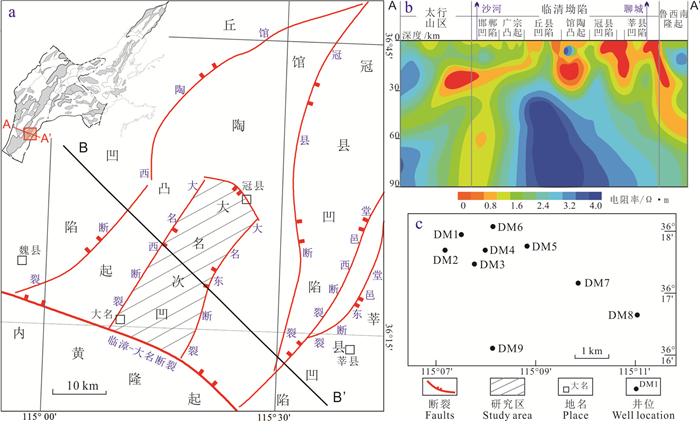
 下载:
下载:
